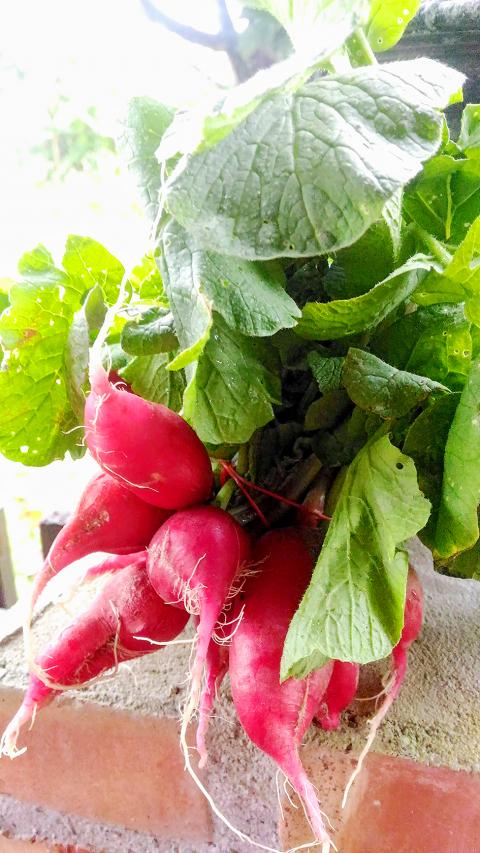The most common kind of radish found in Taiwan is the daikon radish, so much so that it is easy to forget that there are in fact many kinds of radishes around, not least small round red radishes, called cherry radishes (櫻桃蘿蔔), which are an excellent addition to salads, or simply as a refreshing snack.
Locally grown red radishes are not a common sight in the markets, but with the cooler weather at the moment some small farmers are taking advantage of the quick growing cycle of these peppery lovelies to put some on the shelves. And they are such a welcome sight, so perfect for a perky salad, as the autumn weather makes its uncertain, yet inevitable, progress toward winter. Their easy growth and abundant nutrition has not always been associated with such happy situations, with ancient Egyptian records showing that radishes were part of the meager diet fed to the slaves engaged on the construction of the pyramids. It kept them going!
Catching sight of bunches of small red radishes in the local market the other day, I simply could not resist. Asking the stall-holder, out of habit in this case, how these radishes were prepared, I was told that they are excellent in soup. And indeed, these radishes, as indeed most radishes, are excellent in soup, but if you are fortunate enough to find local cherry radishes in a Taiwanese market, soup is really not where you want to put them. They have such wonderful flavor raw, and unless they have been left far too long in the ground (not entirely unlikely), they are wonderfully and refreshingly crisp and tender. The leaves too can be used. This is the case with daikon radish as well, but the leaves, which wilt easily and look unsightly when not perfectly fresh, are usually trashed early on in the marketing process.

Photo: Ian Bartholomew
It is a sad truth that the leaves of carrots, beetroot and radishes, just to name are few, are wasted in vast quantities. Many people are unaware that they can be eaten, and indeed carry a hefty nutritional payload. It is unlikely that beetroot or carrot tops will be available in the supermarket anytime soon. Cherry radishes on the other hand, which grow so quickly and easily, are something that can be managed if you have even a small vegetable area on the balcony. For a vegetable patch, radishes are an excellent crop to plant together with more delicate growths, their strong flavor helping to keep away unwanted pests.
Radishes, like corn, are supposed to be best immediately after harvesting. I am talking minutes rather than days. Deborah Madison in her excellent Vegetable Literacy, a veritable bible for those looking to achieve a greater understanding and skill with plant foods, tells a story of Eugene Walter, a writer from Mobile, Alabama, who tells of his grandfather’s belief that “their [radish’s] soul flies to heaven within an hour after they’re picked.”
I have heard farmers in Hualien insist that to get the best out of corn-on-the-cob, they should not be harvested until the water in which they are to be cooked has already come to a boil. Having tasted both corn and radishes (in both cases grown “naturally,” without chemical enhancement or protection) that have just come in from the field, I cannot but agree that there is some truth to this. Sadly, this is not an option available to everyone, but much can be done even with store-bought radishes to help them shine when they are brought to the table.

Photo: Ian Bartholomew
My own experience is that local farmers tend to leave cherry radishes in the ground for too long, so that the roots become too swollen and often crack, and the leaves become hard, the flavor of both tending toward a slight harshness on the tongue. When tender, the leaves have a peppery spice that is similar to arugula, but when older are closer to carrot tops, and can benefit from a preliminary salting to soften the flavor.
If you are lucky enough to find young and fresh cherry radishes, the best way of dealing with them is to drench them in butter and salt, eating them as a pre-dinner snack with some good French bread. It is the perfect appetizer, the astringency of the roots a great appetite stimulator. The leaves can be thrown into whatever salad you have on hand.
Radishes are amazing for the health of body and mind. They are a rich source of vitamins and minerals and there have been a number of studies that indicate that eating radish, and other members of the cruciferous vegetable family, which include cabbage, cauliflower and broccoli, are beneficial in the prevention of cancer. Anti-fungal properties and support of a healthy digestive system are added advantages.
Ultimately, whatever else might be said of radishes, their real benefit is the kick of flavor they provide to whatever dish they are present in. Daikon has many culinary uses, but it is good to remember that it is not the only kind of radish available. In Asia, the ubiquity of the daikon tends to make people forget that radishes have a very long history, with the establishment of many distinct varieties. Cherry radishes are only one of these, but they are easy to cultivate, and occasionally can be purchased from a small local farmer. Don’t pass up the opportunity.
Radishes with spinach and tofu skin
Recipe
(serves two)
In western countries, the use of tofu skins tends to be dominated by the use of dried skins, sold in dry goods stores and requiring soaking before use. These can be perfectly delicious, but in Taiwan, where many markets have stalls that sell freshly made tofu skins, reliance on the dried variety is a matter of convenience rather than necessity. Our local tofu seller even distinguishes between skins using GMO and non-GMO soy, the latter a bit of a niche product that I have generally found superior in flavor. They make a great foil to fresh radishes, and combine perfectly with a good quality thick soy. As I have mentioned before, and will doubtless say again, get high-quality artisan soy sauce that uses whole soy or black bean in its production. As for the radishes, if the leaves are young and tender, you can skip the salting. With older, coarser leaves, as with dishes such as carrot tops, the salting tenderizes and removes harsh flavors.
Ingredients
2 rolls tofu skin
5 baby radishes, with leaves
2 cloves garlic, minced
1 small bunch young spinach
1 small bunch coriander leaf
1 teaspoon salt, and more for seasoning
Pepper
Vegetable oil
Thick soy
Directions
1. Wash the radishes, scrubbing the roots gently and plucking off the leaves.
2. Finely slice the cleaned roots and set aside. Roughly chop the leaves.
3. Sprinkle the leaves with half a tablespoon of salt, toss so the salt is evenly distributed and set aside for about 20 minutes. The leaves will release moisture. Squeeze dry.
4. Partially unroll the tofu skins and cut into lengths that will fit your skillet. Heat a non-stick skillet with a tablespoon of vegetable oil and, working in batches, fry the tofu skin until golden, adding more oil as necessary. Place the fried skins on kitchen paper to remove excess oil and set aside.
5. Wash and roughly chop the spinach leaves. Wash the coriander and remove the stems.
6. Heat some oil in a large skillet and fry the garlic until fragrant, about 1 minute. Add the spinach and allow to wilt. Season lightly with salt and pepper.
7. Throw in the radish leaves and toss. Remove the spinach and radish leaf mixture, leaving behind any excess liquid.
8. Chop up the tofu skins and toss with the spinach. Add the thinly sliced radish roots and toss. Top with coriander leaves. Drizzle with thick soy and serve.
Ian Bartholomew runs Ian’s Table, a small guesthouse in Hualien. He has lived in Taiwan for many years writing about the food scene and has decided that until you look at farming, you know nothing about the food you eat.
He can be contacted at Hualien202@gmail.com.

Late last month Philippines Foreign Affairs Secretary Theresa Lazaro told the Philippine Senate that the nation has sufficient funds to evacuate the nearly 170,000 Filipino residents in Taiwan, 84 percent of whom are migrant workers, in the event of war. Agencies have been exploring evacuation scenarios since early this year, she said. She also observed that since the Philippines has only limited ships, the government is consulting security agencies for alternatives. Filipinos are a distant third in overall migrant worker population. Indonesia has over 248,000 workers, followed by roughly 240,000 Vietnamese. It should be noted that there are another 170,000

Hannah Liao (廖宸萱) recalls the harassment she experienced on dating apps, an experience that left her frightened and disgusted. “I’ve tried some voice-based dating apps,” the 30-year-old says. “Right away, some guys would say things like, ‘Wanna talk dirty?’ or ‘Wanna suck my d**k?’” she says. Liao’s story is not unique. Ministry of Health and Welfare statistics show a more than 50 percent rise in sexual assault cases related to online encounters over the past five years. In 2023 alone, women comprised 7,698 of the 9,413 reported victims. Faced with a dating landscape that can feel more predatory than promising, many in

“This is one of those rare bits of TikTok fitness advice with a lot of truth behind it,” says Bethan Crouse, performance nutritionist at Loughborough University. “Sometimes it’s taken a bit too literally, though! You see people chugging protein drinks as they’re scanning out of their gym.” Crouse recommends the athletes she works with consume 20-30g of protein within 30-60 minutes of finishing a resistance training session. “The act of exercising our muscles increases the breakdown of muscle proteins,” she says. “In order to restore, or hopefully improve them — and get gains such as increased muscle mass or strength —

“Far from being a rock or island … it turns out that the best metaphor to describe the human body is ‘sponge.’ We’re permeable,” write Rick Smith and Bruce Lourie in their book Slow Death By Rubber Duck: The Secret Danger of Everyday Things. While the permeability of our cells is key to being alive, it also means we absorb more potentially harmful substances than we realize. Studies have found a number of chemical residues in human breast milk, urine and water systems. Many of them are endocrine disruptors, which can interfere with the body’s natural hormones. “They can mimic, block